
To begin with, every Nikon DSLR or Nikon SLR introduced after 1988 does not distinguish between AI and AI-S lenses. Only for five cameras the difference between an AI and an AI-S lens matters: FG (1981), FA (1983), F-301 (1985), F-501 (1986) and F4 (1988). Thus, if you like to use older lenses on your modern camera, this article is not of interest for you. But you should read this one: Using older lenses on your Nikon DSLR
In 1979 Nikon began to build the first AI-S lenses: the series E lenses. In the following months they replaced all their AI lenses with AI-S counterparts without talking it up. In that time some German photo magazines reported about changes in the F-Mount and assumed that the "new" lenses allow the camera body to control the aperture. In 1981 the replacements were completed and Nikon announced the FG, the first Nikon SLR with P mode, for which the camera body must control the aperture. We all expected that the P mode only works with AI-S lenses...
Not a bit of it! The P mode of the FG works with every AI-S, AI or AI modified lens! More than that: in 1983 the semipro FA was introduced, the first Nikon with shutter priority mode (not counting the DS-attachments for the F2). Even here everything works with AI lenses, too. On the other hand Nikon's marketing department told us, AI-S lenses would be the perfect match for the FA. In the "Nikon News", a magazine of Nikon Germany and Nikon Switzerland, they tried to explain us the advantages of the AI-S lenses in conjunction with the FA, but they only beat around the bush.
The truth is: only AI-S lenses allow the control of the aperture. AI oder AI modified lenses don't allow that. It was a trick, which made us to believe that AI lenses could work in shutter priority mode. I guess Nikon rated this trick as unprofessional for themselves - the professional F4, introduced in 1988, offers no S or P mode with non-CPU lenses. It even would have been reliably possible for AI-S lenses, but that is another discussion...
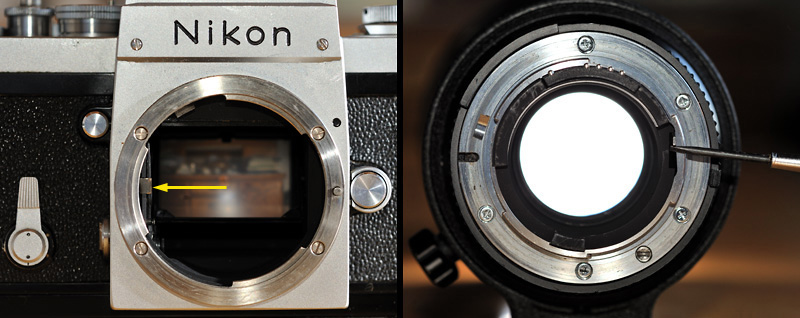
|
|
If you look through the viewfinder of your Nikon camera, the aperture of your lens is kept open by the aperture lever of the camera body (see arrow). The aperture ring of the f/2.8 lens on the right is set to F8. With a small screwdriver I simulate the camera's aperture lever - the aperture is fully open. |
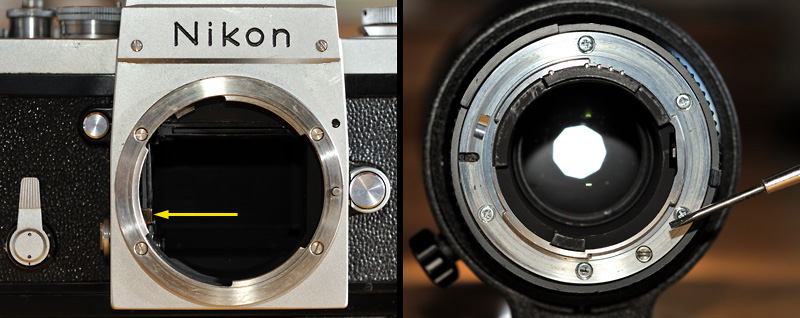
|
|
If you press the shutter release button the aperture lever travels completely down, the mirror flapps up and the shutter opens. The image on the left shows the Nikon F while exposing. The aperture of the lens is stopped down to the preset value. |
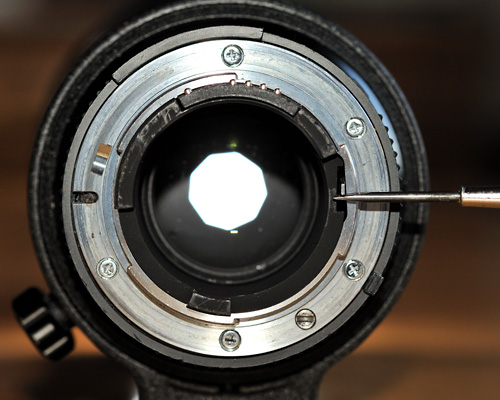
|
The way of controlling the aperture by the camera body is easy!
If your lens has an aperture ring, set it to the smallest aperture (greatest number). By using the screwdriver again and moving carefully the aperture lever of the lens, we can set any aperture we want. Thus, instead of travelling completely down after the shutter release button has been pressed, the camera's aperture lever should just move downwards as much as necessary for setting the aperture to the value the camera has calculated. That's it!
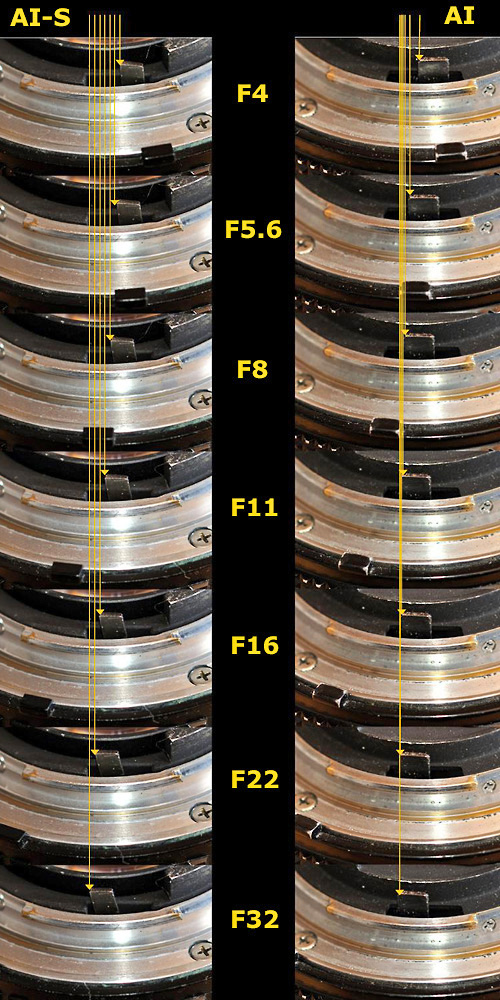
|
Only one question remains: what is the correct position of the lever for stopping down the lens e.g. one or five f-stops?
In most Nikon lenses the aperture lever moves if you turn the aperture ring. The AI Micro-Nikkor 55mm f/3.5 and the AI-S Series E 75-150mm f/3.5 do so. Therefore it is easy for us to detect the position of the levers of the two lenses for the particular aperture values, look to the left.
Lets say we have a 105mm lens. The diameter of the diaphragm opening at F4 is 26mm. At F5.6 it is approx. 18.8mm. For this one f-stop the difference of the diameters is 7.2mm. At F16 and F22 the values are 6.5mm and 4.8mm. Thus, for this f-stop we have a difference of only 1.7mm.
The aperture lever of every pre-AI-S lens that I know shows a corresponding behaviour: the less the aperture blades move for stopping down one further step, the less the aperture lever of the lens travels for the same step. That was the easiest way to build the lens and it works fine, if the aperture value is set on the lens' aperture ring. But it is nearly impossible to exactly control the aperture of such a lens from the camera body, especially for smaller apertures (greater values), as you can see in the example.
In contrast the aperture lever of an AI-S lens travels the same amount for every f-stop. The aperture of an AI-S lens can be exactly controlled by the camera. That is the main thing of an AI-S lens. I guess the "S" stands for shutter priority enabled or something like that.
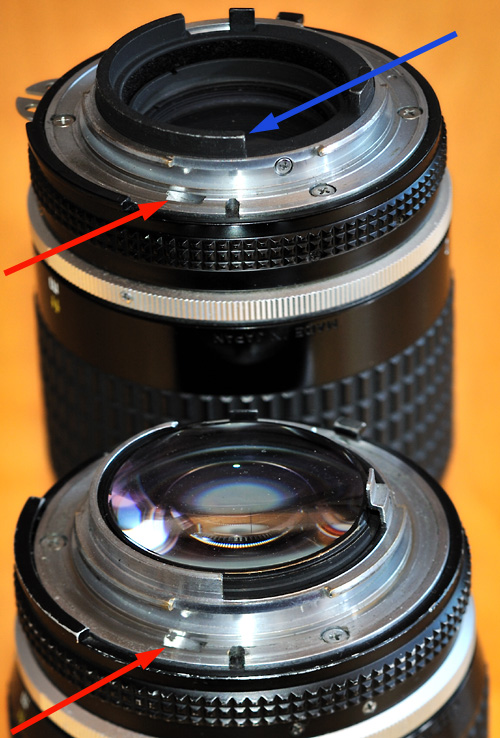
|
|
Two AI-S lenses: the Nikkor 50mm f/1.2 and the Nikkor 200mm f/4. The red arrows point to the AI-S type signal notches. The focal length indexing ridge of the 200mm lens (blue arrow) indicates, that the focal length is 135mm or more. |
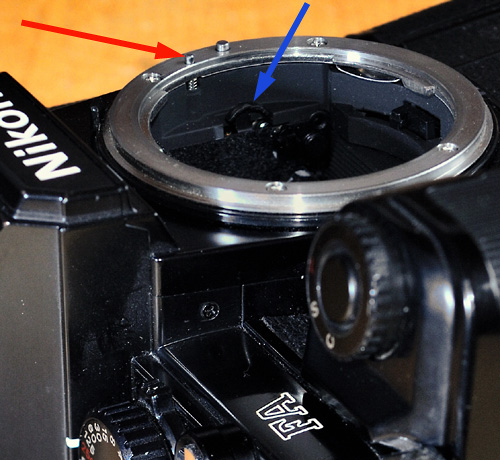
|
|
The mount of the Nikon FA: the red arrow points to the pin that reads the AI-S notch, the blue arrow shows the focal length switch. |
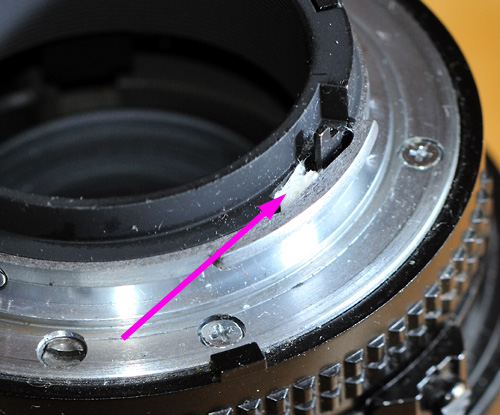
|
|
Evaluating Nikon's trick with a "modified" lens: by pushing pieces of a soft tissue around the aperture lever the lens is a fixed f/3.5 lens now. |
Back to the Nikon FG: It works well with AI-S lenses, but how can it work in P mode with a non-AI-S lens? The metering system measures and calculates the exposure values, lets say F8 and 1/250sec. After pressing the shutter release button the camera positions its aperture lever to the position of F8 of an AI-S lens (which is for example only F5.6 on the mounted lens)! Then, stopped down, a second metering is made in the background. The camera realises that the scene is about one f-stop brighter than expected. It corrects the shutter speed accordingly to 1/500sec and so the exposure will be correct. In my opinion we can call this method to be just ok in P mode, the more so as the calculated aperture value is displayed nowhere.
A camera is able to identify an AI-S lens by a notch in the mount, see image on the right.
The first camera to read this notch was the Nikon FA. If a non-AI-S lens is mounted and S or P mode is selected, the camera positions its aperture lever in a non-linear way, typical for pre-AI-S lenses (see AI lens in example above). Thus the FA works a bit more exact than the FG with non-AI-S lenses. But especially the problems with smaller apertures remain...
You can evaluate the implemented trick by yourself: take your cheapest lens ;o), set it to the smallest aperture number and push some pieces of a tissue around the lens' aperture lever in order to fix it. The aperture of this lens will remain open all the time. As expected, most of the images I took with my "modified" lens on my D700 were clearly overexposed. Not so in conjunction with the FA in P or S mode. Even if the camera told me in S mode it would take F11, the image with my F3.5-fixed lens was properly exposed!
The F-301 and the F-501 read the AI-S signal notch, too, and they work in P mode in the same way the FA does. The F4 was the fourth and the last Nikon SLR that read the notch. Because the F4 does not offer S or P mode with non-CPU lenses, there is no trick implemented in that camera.
AI-S lenses provide another information for the camera body: is the lens a telephoto lens or not. Lenses with focal lengths of 135mm and above have a special ridge that can be read by the camera. Only three Nikon SLRs do so: the FA, the F-501 and the F4.
The FA and the F4 use the information as an additional parameter for the matrix metering. Additionally, the FA and the F-501 use it for the P mode (PDual on F-501), if the ridge is there, shorter shutter speeds are preferred.
Thus, only for having this additional parameter to the metering system, the F4 reads the AI-S notch and, if it is an AI-S lens, the focal length indexing ridge, too. In my eyes that is a lot of mechanical effort for little effect. But I guess there was a hard internal discussion at Nikon about this point and perhaps, they had reached a decision just before the announcement. To use a modern way of speaking: just a firmware update of the F4 would be necessary to allow shutter speed priority mode with AI-S lenses!
As said at the beginning: no, currently not.
The FA, F-501 and the F4 were the queens of reading lens data in a mechanical way. Then there came a phase where the camera bodies were less compatible to the older lenses. For example, the F5, the F100 and the D1 have an AI-coupling, but they don't offer matrix metering with non-CPU lenses due to missing data.
By introducing the D2 series Nikon improved the compatibility to older lenses again in a simple way: the photographer must key in the focal length and the speed of the lens. In the menu of today's DSLRs (with AI coupling) we can define 10 lenses by keying in the data. If you swap from one non-CPU lens to another you just have to select the number of the new lens. With that data the matrix metering can work. More than that: even AI-modified lenses or lenses with AI teleconverters can be used with matrix metering. Besides, the aperture values are displayed in the viewfinder (in contrast to e.g. the F-100, which only shows "F--" with a non-CPU-lens). Thank you, Nikon!
Imagine, additional data would be requested in the lens data menu: an AI-S lens checkbox (Yes/No) and the greatest aperture value. Then AI-S lenses would provide P and S mode and would allow to set the aperture by the camera's control dial! And the possibility for defining non-CPU AI-S lenses in the menu of a CPU-interface-only camera (like D5100 or D3100) would enable the full usability of AI-S lenses (except for AF, of course).